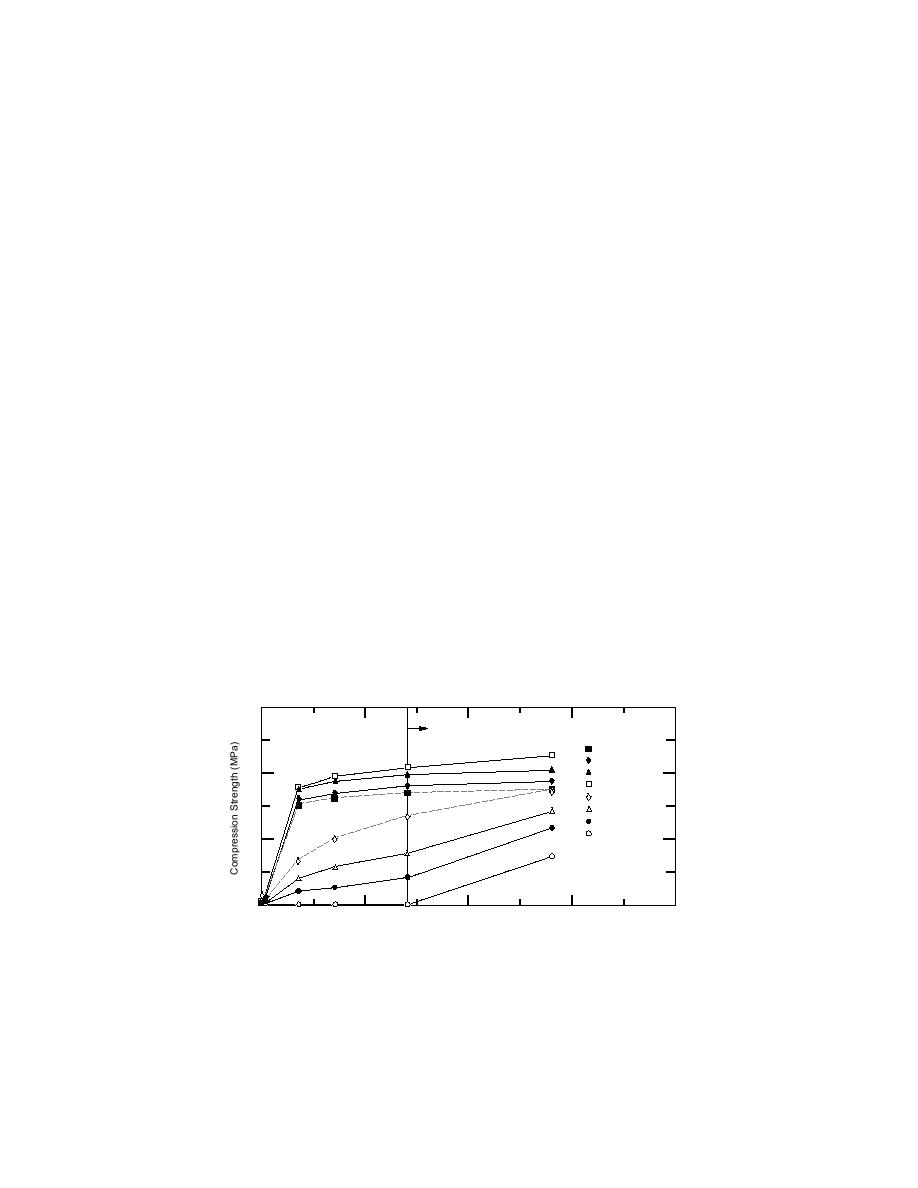
sive than the small samples tested in this task and
in the three colder rooms cooled to below freez-
would likely produce higher concrete tempera-
ing within five hours, showing that essentially all
tures. However, the referenced curves clearly dem-
strength gained by the samples in the cold rooms
onstrate the accelerating effect of Pozzutec 20. In
occurred at the temperature of the particular cur-
all three figures, increased dosages of this admix-
ing room. Therefore, the cold room temperature
ture caused the temperature of the concrete to
can be thought of as the temperature of the con-
rise more quickly and attain higher temperatures
crete.
than did lower dosages. For example, Figure 1a
Figure 2 shows the two most important find-
ings from this task. A complete list of strength
shows that mixture 2,3 produced a concrete tem-
perature that was about 2C (3.6F) higher than
results is provided in Appendix A. As was done
mixture 2,0 and about 1C (1.8F) higher than
with the temperature measurements, the strength
results for the 308-kg/m3 (517 lb/yd3) mixes are
mixtures 2,1 and 2,2. Comparing Figure 1a to 1b
shows that increasing the cement content has the
not provided due to segregation of this mixture.
same accelerating effect as does adding Pozzutec
The first finding of this task was that Pozzutec
20 to the mix. The 3,0 mixture, containing the
20 not only accelerated early strength gain in con-
high cement factor (420 kg/m3) and no admix-
crete but that it also enhanced ultimate strength.
ture, produced a concrete temperature that was
This result can be seen in Figure 2 by comparing
nearly identical to the 2,3 mixture, containing the
the room-temperature strength of the control con-
middle cement factor (365 kg/m3) and Pozzutec
crete (2,0,20) to those of the three concretes made
20. Comparing Figures 1b to 1c shows that the
with Pozzutec 20, cured at room temperature.
high early strength cement produced the same
The low, medium, and high dosages of Pozzutec
temperature that was produced by a higher
20 increased the seven-day strength of concrete
amount of normal cement.
by 5, 16, and 17 percent, respectively, and that of
Figure 1d shows a typical temperature history
the 56-day strengths by 8, 18, and 30 percent,
of samples cured in each of the five curing rooms.
respectively. The second finding was that none of
Samples stored at room temperature briefly rise
the Pozzutec 20 dosages produced acceptable
strengths when cured at 5, 10, or 20C (23, 14,
in temperature before cooling to room tempera-
4F); it is probable that mass concrete produced
ture at about 30 hours. The heat loss for the
in the field with higher dosages (90 fl oz) of
samples in the other rooms was rapid enough to
Pozzutec 20 and curing temperatures above 14F
preclude any rise in temperature. The samples
quickly cooled from about 20C (70F) to ambient
would have acceptable compressive strengths. The
initial goal of this project was to produce an ad-
temperature. Within eight hours the sample in
the 5C (40F) room cooled to ambient while those
mixture that would promote strength in concrete
60
Room Temperature
2, 0, 20
2, 1, 20
2, 2, 20
40
2, 3, 20
ACI @ 5 C
2, 3, 5 C
2, 3, 10 C
2, 3, 20 C
20
0
20
40
60
80
Age (days)
Figure 2. Effect of temperature on strength gain of concrete. The dotted
lines show the strength gain of control concrete at 20C (70F) and 5C
(40F). The 5C (40F) line is based on guidance from ACI (1988). All
results are for concrete made with a 365-kg/m3 (611 lb/yd3) cement factor
cured at a given temperature for 28 days, followed by 28 days of curing at
room temperature.
7



 Previous Page
Previous Page
